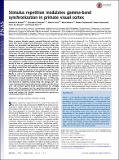| dc.contributor.author | Brunet, Nicolas M. | |
| dc.contributor.author | Bosman, Conrado A. | |
| dc.contributor.author | Vinck, Martin | |
| dc.contributor.author | Roberts, Mark | |
| dc.contributor.author | Oostenveld, Robert | |
| dc.contributor.author | Desimone, Robert | |
| dc.contributor.author | De Weerd, Peter | |
| dc.contributor.author | Fries, Pascal | |
| dc.date.accessioned | 2014-11-05T19:34:59Z | |
| dc.date.available | 2014-11-05T19:34:59Z | |
| dc.date.issued | 2014-02 | |
| dc.date.submitted | 2013-05 | |
| dc.identifier.issn | 0027-8424 | |
| dc.identifier.issn | 1091-6490 | |
| dc.identifier.uri | http://hdl.handle.net/1721.1/91467 | |
| dc.description.abstract | When a sensory stimulus repeats, neuronal firing rate and functional MRI blood oxygen level-dependent responses typically decline, yet perception and behavioral performance either stay constant or improve. An additional aspect of neuronal activity is neuronal synchronization, which can enhance the impact of neurons onto their postsynaptic targets independent of neuronal firing rates. We show that stimulus repetition leads to profound changes of neuronal gamma-band (∼40–90 Hz) synchronization. Electrocorticographic recordings in two awake macaque monkeys demonstrated that repeated presentations of a visual grating stimulus resulted in a steady increase of visually induced gamma-band activity in area V1, gamma-band synchronization between areas V1 and V4, and gamma-band activity in area V4. Microelectrode recordings in area V4 of two additional monkeys under the same stimulation conditions allowed a direct comparison of firing rates and gamma-band synchronization strengths for multiunit activity (MUA), as well as for isolated single units, sorted into putative pyramidal cells and putative interneurons. MUA and putative interneurons showed repetition-related decreases in firing rate, yet increases in gamma-band synchronization. Putative pyramidal cells showed no repetition-related firing rate change, but a decrease in gamma-band synchronization for weakly stimulus-driven units and constant gamma-band synchronization for strongly driven units. We propose that the repetition-related changes in gamma-band synchronization maintain the interareal stimulus signaling and sharpen the stimulus representation by gamma-synchronized pyramidal cell spikes. | en_US |
| dc.description.sponsorship | Human Frontier Science Program (Strasbourg, France) (Organization Grant RGP0070/2003) | en_US |
| dc.description.sponsorship | Volkswagen Foundation (Grant I/79876) | en_US |
| dc.description.sponsorship | European Science Foundation (European Young Investigator Award Program) | en_US |
| dc.description.sponsorship | European Union (HEALTH-F2-2008-200728 Grant) | en_US |
| dc.description.sponsorship | State Offensive for Development of Scientific and Economic Excellence (program grant “Neuronale Koordination Forschungsschwerpunkt Frankfurt”) | en_US |
| dc.description.sponsorship | Netherlands. Ministry of Economic Affairs (Smart Mix Programme) | en_US |
| dc.description.sponsorship | Netherlands. Ministry of Education, Culture, and Science (BrainGain) | en_US |
| dc.description.sponsorship | Netherlands Organization for Scientific Research (Grant 452-03-344) | en_US |
| dc.language.iso | en_US | |
| dc.publisher | National Academy of Sciences (U.S.) | en_US |
| dc.relation.isversionof | http://dx.doi.org/10.1073/pnas.1309714111 | en_US |
| dc.rights | Article is made available in accordance with the publisher's policy and may be subject to US copyright law. Please refer to the publisher's site for terms of use. | en_US |
| dc.source | PNAS | en_US |
| dc.title | Stimulus repetition modulates gamma-band synchronization in primate visual cortex | en_US |
| dc.type | Article | en_US |
| dc.identifier.citation | Brunet, N. M., C. A. Bosman, M. Vinck, M. Roberts, R. Oostenveld, R. Desimone, P. De Weerd, and P. Fries. “Stimulus Repetition Modulates Gamma-Band Synchronization in Primate Visual Cortex.” Proceedings of the National Academy of Sciences 111, no. 9 (February 19, 2014): 3626–3631. | en_US |
| dc.contributor.department | McGovern Institute for Brain Research at MIT | en_US |
| dc.contributor.mitauthor | Desimone, Robert | en_US |
| dc.relation.journal | Proceedings of the National Academy of Sciences | en_US |
| dc.eprint.version | Final published version | en_US |
| dc.type.uri | http://purl.org/eprint/type/JournalArticle | en_US |
| eprint.status | http://purl.org/eprint/status/PeerReviewed | en_US |
| dspace.orderedauthors | Brunet, Nicolas M.; Bosman, Conrado A.; Vinck, Martin; Roberts, Mark; Oostenveld, Robert; Desimone, Robert; De Weerd, Peter; Fries, Pascal | en_US |
| dc.identifier.orcid | https://orcid.org/0000-0002-5938-4227 | |
| mit.license | PUBLISHER_POLICY | en_US |
| mit.metadata.status | Complete | |
